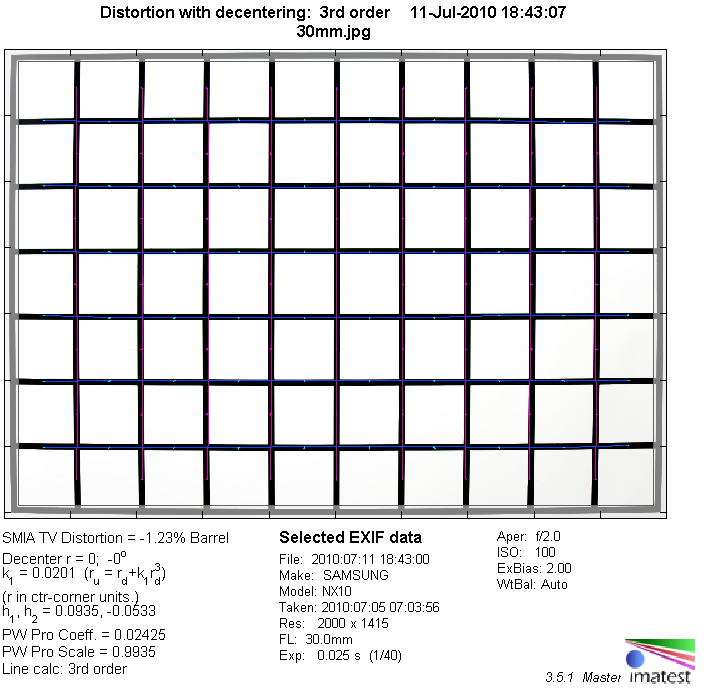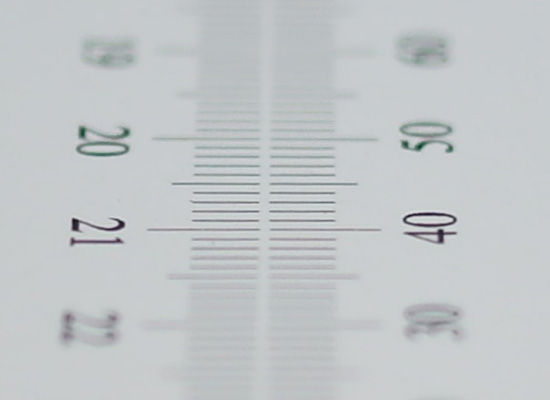|
Samsung NX 30mm f/2 ( S30NB ) - Review / Lens Test - Analysis |
|
Lens Reviews -
Samsung NX
|
|
Page 2 of 3

Distortion
The Samsung lens shows only a slight degree (1.2%) of barrel distortion which is not overly relevant in field situations.

Vignetting
The NX 30mm f/2 produces some visible vignetting about about 1EV (f-stop) at max. aperture. Stopping down to f/2.8 tames the issue substantially and it's not objectionable anymore beyond.
It is interesting to note that these results are quite different compared to our test on the old NX10. At the time we already suspected that the NX10 applied some vignetting compensation. Alternatively - although unlikely regarding the difference - the effect could also originate in the new sensor used in the NX200.

MTF (resolution)
As a little update we've provided the quality ratings for the scenario with and without distortion correction.
Distortion auto-correction DISABLED:
The NX 30mm f/2 produced pretty impressive resolution figures in our MTF lab. The center resolution is excellent straight from the max. aperture. The borders/corners start on a good level here (just) which is decent for such a large aperture setting. Stopping down to f/2.8 results in an extremely sharp center and the outer image region improves a bit as well. The peak performance is reached between f/4-5.6 with a very high quality across the image frame. Diffraction decreases the center performance at f/8 and f/11 whereas the borders/corners can roughly keep their level. It's actually a bit surprising that the lens is still that good at f/11. However, stopping down to f/16 should be generally avoided due to more pronounced diffraction effects (a physical limitation - not a lens issue).
Distortion auto-correction ENABLED:
The distortion correction may fix this issue but, as a side effect, the image gets "stretched" and up-scaled
to the original size. However, due to the image cropping it does also reduce some corner issues.
The center performance is only marginally impacted by this but the corner stretching doesn't come for
free - you are roughly loosing about a 1/3-1/2 quality mark here.
Please note that the MTF results are not directly comparable across the different systems!
Below is a simplified summary of the formal findings. The chart shows line widths
per picture height (LW/PH) which can be taken as a measure for sharpness.
If you want to know more about the MTF50 figures you may check out the corresponding
Imatest Explanations
|
MOVE YOUR MOUSE CURSOR ACROSS THE IMAGE TO OBSERVE THE RESULTS WITH ENABLED AUTO-CORRECTION!
|
 |

|
Chromatic Aberrations (CAs)
The Samsung lens shows only a marginal amount of lateral CAs at the image borders of around 0.5px at the image borders. In extreme contrast situations you may spot some purple fringing at large aperture settings though.

Bokeh
The NX 30mm f/2 behaves like a "46mm f/2.8" in terms of depth-of-field. This is just sufficient to isolate your main subject from the surroundings but you should keep a rather close focus distance to pronounce the effect. The quality of the bokeh (out-of-focus blur) is rather mediocre - we've seen better lenses here. Out-of-focus highlights show a rather pronounced outlining effect and the blur in the focus transition zone can be quite rough.

Bokeh Fringing / Longitudinal Chromatic Aberrations (LoCA)
Bokeh fringing at large apertures is a problem which is often not well corrected. The Samsung does also show these green/purple halos in the focus transition zones. They're quite pronounced at f/2, still visible at f/2.8 and they're not a real issue anymore from f/4 onwards.
|
Move the mouse cursor over the f-stop marks below to observe the respective LoCAs
|
| f/2 |
f/2.8 |
f/4 |
|

|
|